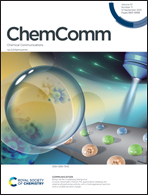Solution NMR of synthetic cavity containing supramolecular systems: what have we learned on and from?†‡
Abstract
NMR has been instrumental in studies of both the structure and dynamics of molecular systems for decades, so it is not surprising that NMR has played a pivotal role in the study of host–guest complexes and supramolecular systems. In this mini-review, selected examples will be used to demonstrate the added value of using (multiparametric) NMR for studying macrocycle-based host–guest and supramolecular systems. We will restrict the discussion to synthetic host systems having a cavity that can engulf their guests thus restricting them into confined spaces. So discussion of selected examples of cavitands, cages, capsules and their complexes, aggregates and polymers as well as organic cages and porous liquids and other porous materials will be used to demonstrate the insights that have been gathered from the extracted NMR parameters when studying such systems emphasizing the information obtained from somewhat less routine NMR methods such as diffusion NMR, diffusion ordered spectroscopy (DOSY) and chemical exchange saturation transfer (CEST) and their variants. These selected examples demonstrate the impact that the results and findings from these NMR studies have had on our understanding of such systems and on the developments in various research fields.



 Please wait while we load your content...
Please wait while we load your content...